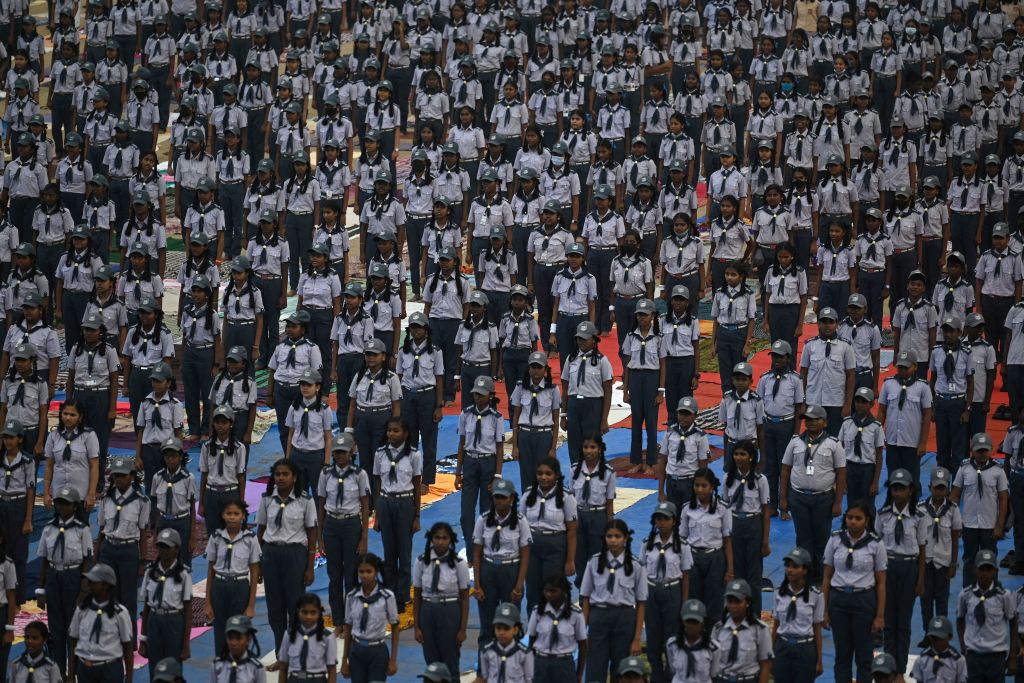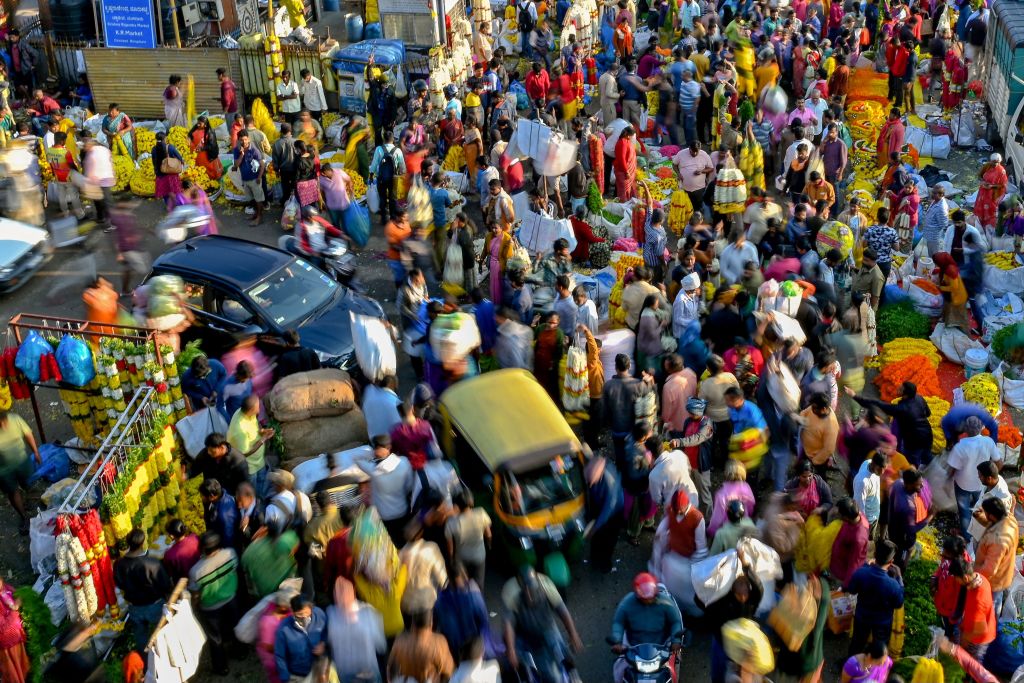
On New Year’s Day in 2021, nearly 60,000 babies were born across India—the highest number of births given anywhere in the world that day, according to UNICEF. The record-breaking number also contributed to India being on track to become the world’s most populous country later this year.
On Wednesday, a newly-released U.N. report projected that India’s population of 1.428 billion will surpass China’s 1.425 billion in 2023. While the UN did not specify a specific date for the demographic crossover, a U.N. spokesperson told TIME that its Department for Economic and Social Affairs estimates this crossover will occur by July 2023.
Experts had already raised this possibility back in January based on estimates from the World Population Review, after China’s National Bureau of Statistics announced that the country’s total population declined by 850,000 between the end of 2021 and the end of 2022.
“There is no ideal population number for India, China, or any other country in the world. Far more interesting is how India and China can best unlock opportunities for their societies and economies, regardless of their size,” the U.N. spokesperson added.
The development marks a new phase in India’s growth on the global stage, riddled with the challenges of managing a rising population, but also an opportunity to “reimagine strategies and build on our successes to provide a healthy and happy life for its people,” Poonam Muttreja, the executive director of the Population Foundation of India (PFI), told TIME.
Read More: How a Historic March Could Revive India’s Opposition Movement
What’s behind India’s growing population?
The biggest factor behind India’s massive population is its young people: 650 million Indians—nearly half the country’s population—are below the age of 25. And experts estimate that India won’t hit its population peak until 2065, which means that even if the younger demographic produces only one or two children per couple, the population size will continue to increase over time before it stabilizes, driving what PFI calls the “population momentum.”
India’s historic lack of family-planning services also means that many Indian women aren’t able to have smaller families. Although India was the first country to adopt family planning as an official policy in 1952, a period of economic and social stagnation led former Prime Minister Indira Gandhi to suspend all civil liberties during The Emergency in 1975. A mass drive to sterilize men compulsorily was also launched, which became so unpopular as a population control method that for the next two decades, subsequent governments didn’t broach the topic of family planning at all. Instead, population control methods have focused on women: between 2013 and 2014, India carried out the majority of nearly 4 million sterilizations on women, according to government statistics. Until 2017, India’s public healthcare system also didn’t offer many contraceptive choices to men or women, something which Muttreja believes needs to change.
“We must empower our women to be able to decide if, when, and how many children to have,” she said.
Contrary to popular perception, however, India’s population growth rate has actually slowed down in the last few decades—from a 24.7% growth between 1971 and 1981 to a 17.7% growth between 2001 and 2011—due to the rising levels of education and healthcare, as well as the alleviation of poverty.
PFI adds that India can learn from China’s shrinking population by achieving low fertility rates without imposing further population control methods. “India must put an end to the noise around the possible introduction of a two-child norm,” said Muttreja, adding that a few Southern Indian states like Kerala, Tamil Nadu, and Andhra Pradesh have already achieved this by providing better access to education and development opportunities.

What impact will India’s population have on the country—and the rest of the world?
Becoming the world’s most populous country can signal a “paradigm shift” for India’s development, Muttreja said. That’s because the country’s younger population also comes with a huge potential to boost the economy—what economists usually call the “demographic dividend.” In 2021, the working-age population of India stood at a whopping 900 million, according to OECD data.
Almost 40 years ago, India’s population boom was described in menacing terms like “population explosion” and the “brain drain”, a reference to India’s young, skilled labor force that migrates to the West in search of better rewards for their potential. But SY Quraishi, who authored the book, “The Population Myth: Islam, Family Planning and Politics in India,” said that both these concepts have changed over time. Today, this same labor force has instead become what he calls “human resources,” or a boom to the Indian economy: “They are the CEOs of the world, and the source of an economic revolution that gives back 90 billion dollars in remittances from abroad,” Quraishi said.
More from TIME
This group isn’t just young, it’s also dynamic: it grew up in a market economy with access to the Internet and a hunger to compete on the global stage. Two-thirds of the Indian population has access to smartphones, thanks to cheap data plans in the last decade. “This generation of young Indians will be the largest consumer and labor source in the knowledge and network goods economy,” writes the U.S.-based Indian economist Shruti Rajagopalan.
And with rising tensions between China and the West, India has become an important player on the world stage. It will lead the charge on the G-20 this year, and as a founding member of the U.N., experts suggest it may even eye a permanent seat on the U.N. Security Council, of which China, but not India, is a permanent member. The country is also boosting production capacity by attracting international conglomerates like Apple, and turning smaller cities like Pune and Chennai into hubs of manufacturing, innovation, and technology.
Read More: China’s Aging Population Is a Major Threat to Its Future
What’s more, a decreasing skilled population across Europe and America has resulted in a shortage of manpower, making India’s population an asset that’s “politically important and indispensable,” Quraishi said. “Other countries may be hating India, but they love our market.”
But India has its challenges, too
Despite the obvious advantages of having a populous country, Quraishi added that the Indian government has failed to prioritize the upskilling of its young people, given that India’s labor force participation rate, which accounts for how much of the country’s working-age population works or wants to work, is it a mere 40%.
Millions of young Indians feel discouraged by their job prospects and actively decide to opt out of working, choosing instead to continue studying, stay home or rely on their family members for financial support. India’s high unemployment rate has hovered around 7 to 8% in the last year (rising from 5 to 6% in 2021), according to the Centre for Monitoring Indian Economy (CMIE), which has led to a shrinking workforce.
To absorb the young working population, India will need to create at least 90 million new non-farming jobs by 2030, a 2020 report by McKinsey Global Institute states. Muttreja and the PFI agree, noting that the government also needs to invest in a “time-bound manner” so that young people are productive and can contribute to the national economy.
“In order to leverage the demographic dividend, the country will have to place the youth at the center of its policies,” she said.
She added that India needs to include those who have traditionally been excluded from its development agenda in order to harness the full potential of its young people—notably, women who continue to have more children than they wish to have and, more broadly, the vast majority of women—by removing barriers to women’s agency and reproductive autonomy.
“India can do better by investing in women’s equity and economic development,” she said.
More Must-Reads From TIME
- The 100 Most Influential People of 2024
- The Revolution of Yulia Navalnaya
- 6 Compliments That Land Every Time
- What's the Deal With the Bitcoin Halving?
- If You're Dating Right Now , You're Brave: Column
- The AI That Could Heal a Divided Internet
- Fallout Is a Brilliant Model for the Future of Video Game Adaptations
- Want Weekly Recs on What to Watch, Read, and More? Sign Up for Worth Your Time
Write to Astha Rajvanshi at astha.rajvanshi@time.com